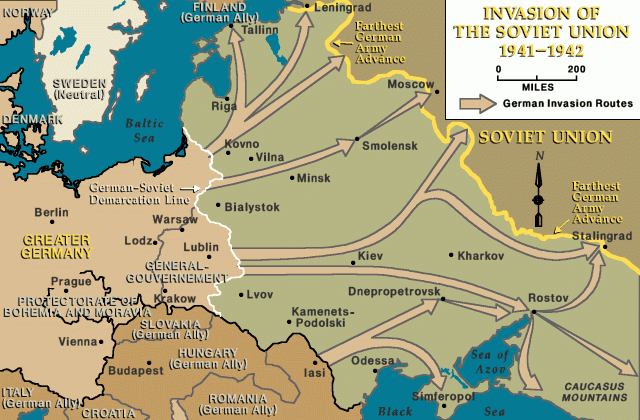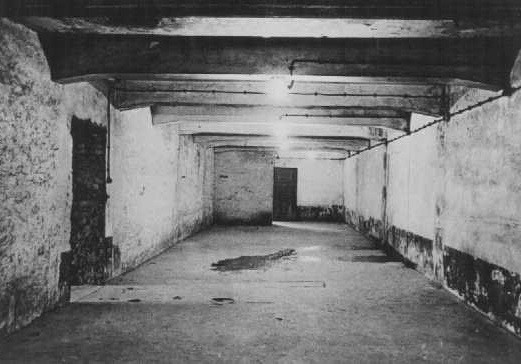
An early concentration camp
Many of the early concentration camps were improvised. Here, roll call is held for political prisoners aboard a ship used as a floating concentration camp. Ochstumsand camp, near Bremen, Germany, 1933 or 1934.
Staatsarchiv Bremen
Between 1933 and 1945, Nazi Germany established approximately 20,000 camps to imprison millions of victims. These camps were used in many forms, including forced labor camps, temporary camps used as transit stations, and extermination camps built primarily and specifically for slaughter. After coming to power in 1933, the Nazi regime established a series of detention camps for the imprisonment and disposal of so-called “enemies of the state.” The first concentration camp prisoners were German Communists, Socialists, Social Democrats, Roma (Gypsies), Jehovah's Witnesses, homosexuals, and people accused of "asocial" or socially deviant behavior. Since the people arrested in these facilities were "gathered" in one place, they were called "concentration camps".
Following Germany's annexation of Austria in May 1938, the Nazis arrested German and Austrian Jews and imprisoned them in the Dachau, Buchenwald, and Sachsenhausen concentration camps in Germany. After the bloody Kristallnacht (“Night of Broken Glass”) massacres in November 1938, the Nazis arrested adult Jewish males en masse and briefly imprisoned them in camps.
After Germany invaded Poland in September 1939, the Nazis established forced labor camps where thousands of prisoners lost their lives due to exhaustion, hunger and exposure. SS units were guarding the camps.
II. During World War II, the Nazi camp system spread rapidly. In some camps, Nazi doctors performed medical experiments on prisoners.

Invasion of the Soviet Union, 1941–1942
US Holocaust Memorial Museum
Following Germany's invasion of the Soviet Union in June 1941, the Nazis increased the number of prisoner of war camps. In occupied Poland, new camps were established within existing concentration camp complexes (such as Aushwitz). The camp in Lublin, later known as Majdanek, was established as a prisoner of war camp in the autumn of 1941 and became a concentration camp in 1943. Thousands of Soviet prisoners of war were shot or poisoned in gas chambers in this camp.
To facilitate the “Final Solution” (the genocide or mass extermination of the Jews), the Nazis established extermination camps in Poland, where the Jewish population was highest. Extermination camps were designed to carry out the massacre effectively. The first of the extermination camps, Chelmno, was established in December 1941. In Chelmno, Jews and Roma were killed in mobile gas carts. In 1942, the Nazis established extermination camps in Belzec, Sobibor and Treblinka to systematically kill the Jews of the Generalgouvernement (the interior of occupied Polish territory).

The former gas chamber in the Auschwitz main camp.
Post-war photo of the gas chamber where the mass murder took place at the Auschwitz main camp. Poland, around 1947. In mid-August 1940, Auschwitz concentration camp authorities activated a crematorium next to the morgue. This building was located just outside the borders of the Auschwitz main camp. In September 1941, the morgue was converted into a gas chamber for mass murder, in which several hundred people could be killed at once. This gas chamber was used until December 1942; however, the crematorium remained in operation until July 1943. In 1944, camp authorities dismantled the crematorium's furnaces and converted the building into an air raid shelter for SS officers working in the SS hospital and administrative buildings near the camp. During the construction of the Auschwitz-Birkenau State Museum in 1947, two crematorium furnaces and the crematorium chimney were reconstructed—using original parts. Around this time, the air raid shelter walls were demolished to allow visitors to the museum and memorial to view the reconstructed gas chamber and crematorium area.
Dokumentationsarchiv des Oesterreichischen Widerstandes
The Nazis built gas chambers (chambers filled with poisonous gas to kill those inside) to increase the efficiency of killing and to make the killing process impersonal for the perpetrators. There were four gas chambers in the Birkenau extermination camp in the Auschwitz complex. As deportations to the camp reached their highest level, approximately 6,000 Jews were being poisoned and killed in the gas chamber every day.
Jews living in Nazi-occupied territories were first deported to Westerbork in the Netherlands or the Drancy temporary camp in France on their journey to the killing centers in occupied Poland. Temporary camps were often the last stop before the extermination camp.
Millions of people were imprisoned and mistreated in different types of Nazi camps. Under SS rule, the Germans and their collaborators killed more than three million Jews in extermination camps alone. Prisoners in Nazi camps
